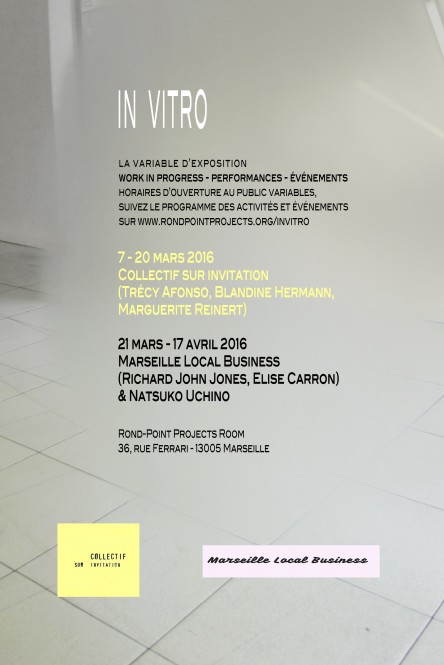Du 07/03/2016 au 17/04/2016

7 – 20 mars 2016 : Collectif sur invitation (Trécy Afonso, Blandine Herrmann, Marguerite Reinert)
21 mars – 17 avril 2016 : Marseille Local Business (Richard John Jones et Elise Carron) & Natsuko Uchino
work in progress – performances – événements
horaires d’ouverture au public variables,
suivez le programme des activités et événements
sur www.rondpointprojects.org/invitro
In Vitro – la variable d’exposition est une proposition curatoriale qui consiste à inviter deux collectifs d’artistes à investir successivement l’espace du Rond-Point Projects Room pour faire de la dimension de l’exposition l’un des paramètres d’un processus de création et de production en cours. L’expression latine fait ici directement référence à la configuration de ce petit espace largement vitré qui expose les activités menées à l’intérieur aux regards des passants, et réciproquement. Les temporalités et modes de visibilité, d’échange et de confrontation avec le public peuvent varier et il revient aux artistes de jouer de ces modulations en fonction des besoins de leur travail. Si la question de l’exposition est inéluctable, c’est ici moins comme une finalité que comme variable d’un protocole expérimental.
In Vitro – la variable d’exposition is a curatorial project in which two artists collectives are invited to occupy the Rond-Point Projects Room one after the other. They are encouraged to use the various exhibition possibilities of the space to inform their processes of creating and producing. The title ‘In vitro’ refers to the features of this small space characterised by its large shop windows that expose all the activities and events happening (or not) inside to the looks of passers-by. The artists are free to occupy the space and address and exchange with the audience as much as their work demands. Here the questions of what and how to exhibit, as well as the notion of exposure become crucial, not simply as an end point of the work, but as part of an on-going process.